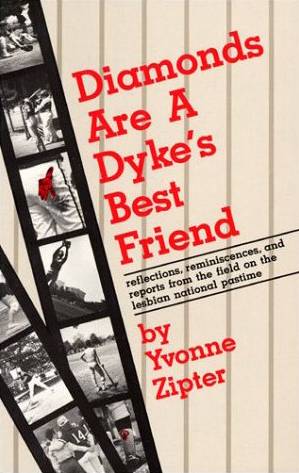Diamonds Are a Dyke’s Best Friend
Reflections, Reminiscences, and Reports from the Field on the Lesbian National Pastime
Yvonne Zipter
Review
Diamonds Are a Dyke’s Best Friend is an educational and thought-provoking work about a sport that so many Lesbians are involved in-but few reflect upon as more than just a game. — Mindy Daniels, The Washington Blade, December 2, 1988
On the cover of this book, Yvonne Zipter describes herself as a right fielder, copy editor, and nationally syndicated columnist. She might have added ‘feminist sport scholar’ since the book represents a thorough and insightful feminist analysis of softball-the ‘lesbian national pastime’-written primarily for a non-academic audience.
In 1988, the mere publication of a book such as this was a triumph for both women’s sport and lesbian sportswomen. It is not coincidental that . . . the forbidden word ‘dyke’ appears proudly in the title. Zipter’s book remains one of a kind-a book by, for, and about lesbian softball players. I have cited the book many times in my own work, always with a feeling of satisfaction that this cheeky title will appear on the pages of an academic journal! — Aethlon, Fall 1997
The analysis throughout is unapologetically feminist, and this is one of the books’ major strengths. . . . The book also does a convincing job of explaining the attraction that softball holds for lesbians, a question rarely addressed in sport or feminist literature. — Helen Lenskyj, Broadside, vol. 10, no. 4
This is a thoughtful, passionate piece of work. . . . Diamonds is a wonderful look at how softball is woven into our lives, our heritage, our sensibilities. For jocks, fans, and academics alike, this is a must read. — Women in Libraries, November/December 1988
Yvonne Zipter’s small paperback edition purports to address the plight as well as the progress of women involved with America’s national pastime. The theme of this defiant book is captured in its subtitle, and those flagrant words are enough to assure that most straight women—and most male baseball fans as well-will never give this book a second look. Actually, Zipter is writing largely about softball-not about baseball of the hardball or professional variety. And she does have some excellent points to make about the hostile environment which the national game has always provided for women, as well as about the position of the female athlete in our society. Yet the diatribe which the title suggests is, in the end, the book’s essential thrust. Since little is said here about the true history of women in baseball, the book does the cause of female players and fans far more disservice than almost all the age-old male rebuffs combined. Women have indeed been badly treated by the national game. Pam Postema’s effort to become baseball’s first female umpire at the big-league level seems now to be dying on the vine at the AAA level. Early abortive attempts of women to play professionally were quickly squashed by the male establishment (as when the Chattanooga Lookouts tried to sign female fastballer Jackie Mitchell to a minor league contract in 1931, after she struck out Ruth and Gehrig in an exhibition game). ‘Me AllAmerican Girls Professional League has been largely buried by male historians. In baseball fiction, women have been almost exclusively assigned stereotyped roles-by male and female authors alike-as useless girlfriends, evil seductresses, meddling mothers, and dumb broads-in spite of the fact that some of the best baseball fiction has been written by women. Zipter tackles some of these issues surrounding the ambivalence of baseball and its establishment toward women. She provides a short but intriguing history of the AAGPL_ perhaps the highlight of the book–though it doesn’t go far enough in its detail or thematic prontinence. She argues that young women should be allowed to play real baseball, and not relegated to softball. But any belief that women have a true place in baseball (versus softball) is quickly undercut by the author’s own thesis that amateur softball is exclusively the woman player’s special niche, and furthermore, that women’s softball leagues are largely the exclusive community of the lesbian subculture. In the end this book proves to be almost everything that its title forebodes-a heavy-handed statement that softball is the special refuge of the dyke community. There is desperate need for a scholarly book detailing female involvement with America’s national pastime, but this certainly is not that book. — From Independent Publisher
From the Back Cover
I hope this book is the first in our own Time/Life series on lesbians and sports. Next we’ll look at the L in LPGA. Up close and personal. Sports Illustrated, eat your heart out. -Kate Clinton
Country dykes, city dykes, dykes with four-year-degrees, dykes who are feminists, dykes who aren’t, dykes of different races and classes, dykes who have been athletes all their lives, and dykes who are just discovering, or rediscovering after years, the values of athletic endeavors-there are softball players among all their ranks.
Check for it on:
Details
| ISBN | 9780932379474 |
| Genre | Sports |
| Publication Date | Mar-89 |
| Publisher | Firebrand Books |
| Format | Trade Paperback |
| No. of Pages | 224 |
| Language | English |
| Rating | NotRated |
| Subject | Lesbians; Lesbians – Recreation – United States; Lesbians/ Recreation/ United States; Softball For Women |
| BookID | 3031 |

